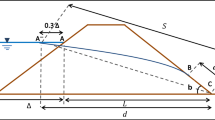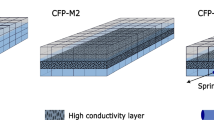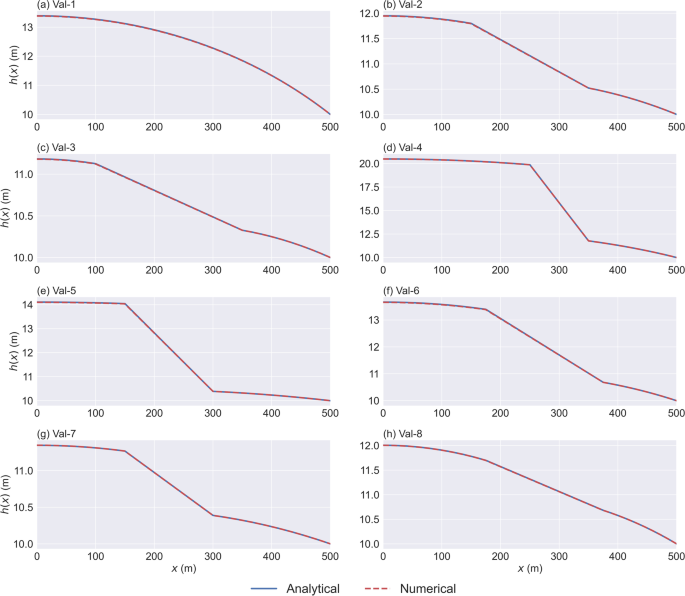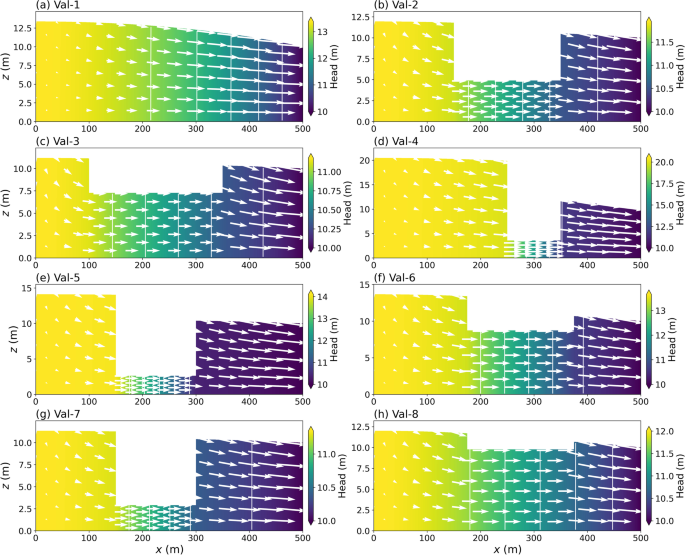Abstract
Estimation of groundwater travel time distribution (TTD) is critical to environmental assessment and successful urban water management. This paper presents a novel analytical approach to account for the groundwater TTD in an unconfined aquifer, considering the impervious urban structure and the modified aquifer hydraulic properties due to consolidation processes. The analytical solution follows the Dupuit-Forchheimer assumption and is verified through comparisons with numerical results. Sensitivity study reveals a potential increase in the mean travel time when the aquifer intersects with an impervious underground structure, while the degree of change depends on the interplay of two mechanisms (i.e., the increase in upgradient groundwater storage and the decrease in pore space of the consolidated zone). Global sensitivity analysis suggests that urban groundwater TTD systems are strongly dependent on both construction-related parameters and aquifer compressibility, indicating that adaptive strategies of groundwater management should be taken for different aquifer types. The proposed analytical model has great implications for the management of water resources in urban areas, the utilization of urban groundwater for human consumption, and the quality of urban aquifers.
Résumé
L’estimation de la distribution du temps de transit des eaux souterraines (DTT) est essentielle pour l’évaluation environnementale et la gestion réussie des eaux urbaines. Cet article présente une nouvelle approche analytique pour prendre en compte la DTT des eaux souterraines dans un aquifère libre, en considérant la structure urbaine imperméable et les propriétés hydrauliques modifiées de l’aquifère dues aux processus de consolidation. La solution analytique suit l’hypothèse de Dupuit-Forchheimer et est vérifiée par comparaison avec les résultats numériques. L’étude de sensibilité révèle une augmentation potentielle du temps de parcours moyen lorsque l’aquifère intercepte une structure souterraine imperméable, tandis que le degré de changement dépend de l’interaction de deux mécanismes (c’est-à-dire l’augmentation du stockage des eaux souterraines en amont et la diminution de l’espace poreux de la zone consolidée). L’analyse de sensibilité globale suggère que les systèmes de DTT des eaux souterraines urbaines dépendent fortement à la fois des paramètres liés à la construction et de la compressibilité de l’aquifère, ce qui indique que des stratégies adaptatives de gestion des eaux souterraines doivent être prises en considérant les différents types d’aquifères. Le modèle analytique proposé a de grandes implications pour la gestion des ressources en eau dans les zones urbaines, l’utilisation des eaux souterraines urbaines pour la consommation humaine, et pour la qualité des aquifères en milieu urbain.
Resumen
La estimación de la distribución del tiempo de tránsito de las aguas subterráneas (TTD) es fundamental para la evaluación medioambiental y para el éxito de la gestión del agua urbana. Este trabajo presenta un nuevo enfoque analítico para considerar el TTD de las aguas subterráneas en un acuífero no confinado, teniendo en cuenta la estructura urbana impermeable y las propiedades hidráulicas modificadas del acuífero debido a los procesos de consolidación. La solución analítica sigue la hipótesis de Dupuit-Forchheimer y se verifica mediante comparaciones con resultados numéricos. El estudio de sensibilidad revela un aumento potencial del tiempo medio de tránsito cuando el acuífero se cruza con una estructura subterránea impermeable, mientras que el grado de cambio depende de la interacción de dos mecanismos (es decir, el aumento del almacenamiento de agua subterránea ascendente y la disminución del espacio poroso de la zona consolidada). El análisis de sensibilidad global sugiere que los sistemas de TTD de aguas subterráneas urbanas dependen en gran medida tanto de los parámetros relacionados con la construcción como de la compresibilidad del acuífero, lo que indica que deben adoptarse estrategias adaptativas de gestión de las aguas subterráneas para los distintos tipos de acuíferos. El modelo analítico propuesto tiene importantes implicancias para la gestión de los recursos hídricos en las zonas urbanas, la utilización de las aguas subterráneas para el consumo humano y la calidad de los acuíferos urbanos.
摘要
地下水运移时间分布(TTD)对于环境评估和成功的城市水管理至关重要。本文提出了一种新的分析方法,结合不透水城市结构和固结过程导致的含水层水力特性变化,计算非承压含水层中的地下水运移时间分布(TTD)。分析方法遵循Dupuit-Forchheimer假设,并通过与数值结果的比较进行验证。敏感性研究表明,当含水层与不透水地下结构相交时,地下水运移的平均时间可能增加,而变化程度取决于两种机制的相互作用(即,上游地下水储量增加和固结区孔隙空间减少)。全球敏感性分析表明,城市地下水运移时间分布系统强烈依赖于施工相关参数和含水层压缩性,这表明应针对不同含水层类型采取地下水管理的对应策略。本次提出的分析模型对城市水资源管理、城市地下水开发利用以及城市含水层质量具有重要意义。
Resumo
A estimativa da distribuição do tempo de trânsito (DTT) das águas subterrâneas é fundamental para a avaliação ambiental e a gestão bem-sucedida das águas urbanas. Este artigo apresenta uma nova abordagem analítica para contabilizar a DTT das águas subterrâneas em um aquífero livre, considerando a estrutura urbana impermeável e as propriedades hidráulicas do aquífero modificadas devido aos processos de consolidação. A solução analítica segue a hipótese de Dupuit-Forchheimer e é verificada por meio de comparações com resultados numéricos. O estudo de sensibilidade revela um aumento potencial no tempo de trânsito médio quando o aquífero cruza com uma estrutura subterrânea impermeável, enquanto o grau de mudança depende da interação de dois mecanismos (ou seja, o aumento do armazenamento de águas subterrâneas ascendentes e a diminuição do espaço poroso da zona consolidada). A análise de sensibilidade global sugere que os sistemas de DTT de águas subterrâneas urbanas são fortemente dependentes tanto dos parâmetros relacionados à construção quanto da compressibilidade do aquífero, indicando que estratégias adaptativas de gestão de águas subterrâneas devem ser adotadas para diferentes tipos de aquíferos. O modelo analítico proposto tem grandes implicações para a gestão dos recursos hídricos em áreas urbanas, a utilização das águas subterrâneas urbanas para consumo humano e a qualidade dos aquíferos urbanos.
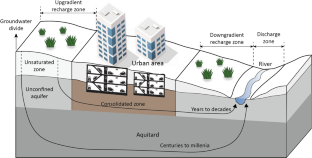








Similar content being viewed by others
References
Alshawabkeh AN, Rahbar N (2006) Parametric study of one-dimensional solute transport in deformable porous media. J Geotech Geoenviron 132(8):1001–1010. https://doi.org/10.1061/(ASCE)1090-0241(2006)132:8(1001)
Ameli AA, Amvrosiadi N, Grabs T, Laudon H, Creed IF, McDonnell JJ, Bishop K (2016) Hillslope permeability architecture controls on subsurface transit time distribution and flow paths. J Hydrol 543:17–30. https://doi.org/10.1016/j.jhydrol.2016.04.071
Attard G, Rossier Y, Eisenlohr L (2016) Urban groundwater age modeling under unconfined condition: impact of underground structures on groundwater age—evidence of a piston effect. J Hydrol 535:652–661. https://doi.org/10.1016/j.jhydrol.2016.02.034
Bhaskar AS, Beesley L, Burns MJ, Fletcher TD, Hamel P, Oldham CE, Roy AH (2016) Will it rise or will it fall? Managing the complex effects of urbanization on base flow. Freshwater Science 35(1):293–310. https://doi.org/10.1086/685084
Bjørlykke K (2003) Compaction (consolidation) of sediments. In: Middleton GV, Church MJ, Coniglio M, Hardie LA, Longstaffe FJ (eds) Encyclopedia of sediments and sedimentary rocks. Springer, Dordrecht, The Netherlands, pp 161–168. https://doi.org/10.1007/978-1-4020-3609-5_53
Bonazzi A, Jha B, de Barros FPJ (2021) Transport analysis in deformable porous media through integral transforms. Int J Numer Anal Methods Geomech 45(3):307–324. https://doi.org/10.1002/nag.3150
Bonneau J, Burns MJ, Fletcher TD, Witt R, Drysdale RN, Costelloe JF (2018) The impact of urbanization on subsurface flow paths: a paired-catchment isotopic study. J Hydrol 561:413–426. https://doi.org/10.1016/j.jhydrol.2018.04.022
Carman PC (1937) Fluid flow through granular beds. Trans Inst Chem Eng 15:150–166
Chesnaux R, Molson JW, Chapuis RP (2005) An analytical solution for ground water transit time through unconfined aquifers. Ground Water 43(4):511–517. https://doi.org/10.1111/j.1745-6584.2005.0056.x
Connor R (2015) The United Nations world water development report 2015: Water for a sustainable world, vol 1. UNESCO, Paris
Dupuit JÉJ (1863) Études théoriques et pratiques sur le mouvement des eaux dans les canaux découverts et à travers les terrains perméables: avec des considérations relatives au régime des grandes eaux, au débouché à leur donner, et à la marche des alluvions dans les rivièr [Theoretical and practical studies on the movement of water in open channels and through permeable soils: with considerations relating to the regime of large waters, the outlet to be given to them, and the course of alluvium in rivers]. Dunod, Paris
Eberts SM, Böhlke JK, Kauffman LJ, Jurgens BC (2012) Comparison of particle-tracking and lumped-parameter age-distribution models for evaluating vulnerability of production wells to contamination. Hydrogeol J 20(2):263–282. https://doi.org/10.1007/s10040-011-0810-6
Eriksson E (1958) The possible use of tritium’ for estimating groundwater storage. Tellus 10(4):472–478. https://doi.org/10.1111/j.2153-3490.1958.tb02035.x
Etcheverry D (2001) Une approche déterministe des distributions des temps de transit de l’eau souterraine par la théorie des réservoirs [A deterministic approach to groundwater transit time distributions using reservoir theory]. University of Neuchâtel, Neuchâtel, Switzerland
Etcheverry D, Perrochet P (2000) Direct simulation of groundwater transit-time distributions using the reservoir theory. Hydrogeol J 8(2):200–208
Font-Capo J, Pujades E, Vàzquez-Suñé E, Carrera J, Velasco V, Montfort D (2015) Assessment of the barrier effect caused by underground constructions on porous aquifers with low hydraulic gradient: a case study of the metro construction in Barcelona, Spain. Eng Geol 196:238–250. https://doi.org/10.1016/j.enggeo.2015.07.006
Forchheimer P (1886) Über die Ergiebigkeit von Brunnen-Anlagen und Sickerschlitzen [On the productivity of well systems and seepage slits]. Arch-and-Ing-Verein zu Hannover, Hanover, Germany, pp 539–563
Gambolati G, Teatini P (2015) Geomechanics of subsurface water withdrawal and injection. Water Resour Res 51(6):3922–3955
Goode DJ (1996) Direct simulation of groundwater age. Water Resour Res 32(2):289–296. https://doi.org/10.1029/95WR03401
Haitjema HM (1995) On the residence time distribution in idealized groundwater sheds. J Hydrol 172:127–146
Haitjema HM, Mitchell-Bruker S (2005) Are water tables a subdued replica of the topography? Ground Water 43(6):781–786. https://doi.org/10.1111/j.1745-6584.2005.00090.x
Han WS, Burian SJ (2009) Determining effective impervious area for urban hydrologic modeling. ASCE J Hydrol Eng 14(2):203–206. https://doi.org/10.1061/(ASCE)1084-0699(2009)14
Harbaugh AW (2005) MODFLOW-2005, The U.S. Geological Survey Modular Ground-Water Model: the ground-water flow process. US Geological Survey Techniques and Methods 6-A16
Healy RW (2010) Estimating groundwater recharge. Cambridge University Press, Cambridge, UK
Jing M, Kumar R, Heße F, Thober S, Rakovec O, Samaniego L, Attinger S (2020) Assessing the response of groundwater quantity and travel time distribution to 1.5, 2 and 3 degrees global warming in a mesoscale central German basin. Hydrol Earth Syst Sci 24:1511–1526. https://doi.org/10.5194/hess-24-1511-2020
Jing M, Kumar R, Attinger S, Li Q, Lu C, Heße F (2021a) Assessing the contribution of groundwater to catchment travel time distributions through integrating conceptual flux tracking with explicit Lagrangian particle tracking. Adv Water Resour 149:103849. https://doi.org/10.1016/j.advwatres.2021.103849
Jing M, Lu C, Heße F, Kumar R (2021b) A novel analytical model for the transit time distributions in urban groundwater systems. J Hydrol 127379. https://doi.org/10.1016/j.jhydrol.2021.127379
Knappett J, Craig RF (2019) Craig’s soil mechanics. CRC, Boca Raton, FL
Kozeny J (1927) Ueber kapillare Leitung des Wassers im Boden [On the capillary conduction of water in the soil]. Sitzungsber Akad Wiss, Vienna, Austria Proceedings, Class 1, 136(2a), pp 271–306
Lee J, Fox PJ, Lenhart JJ (2009) Investigation of consolidation-induced solute transport. I: effect of consolidation on transport parameters. J Geotech Geoenviron 135(9):1228–1238. https://doi.org/10.1061/(ASCE)GT.1943-5606.0000047
Leray S, de Dreuzy JR, Bour O, Labasque T, Aquilina L (2012) Contribution of age data to the characterization of complex aquifers. J Hydrol 464–465:54–68. https://doi.org/10.1016/j.jhydrol.2012.06.052
Leray S, Engdahl NB, Massoudieh A, Bresciani E, McCallum J (2016) Residence time distributions for hydrologic systems: mechanistic foundations and steady-state analytical solutions. J Hydrol 543:67–87. https://doi.org/10.1016/j.jhydrol.2016.01.068
Leray S, Gauvain A, de Dreuzy J (2019) Residence Time Distributions in non-uniform aquifer recharge and thickness conditions: an analytical approach based on the assumption of Dupuit-Forchheimer. J Hydrol 574:110–128. https://doi.org/10.1016/j.jhydrol.2019.04.032
Lerner DN (2002) Identifying and quantifying urban recharge: a review. Hydrogeol J 10(1):143–152. https://doi.org/10.1007/s10040-001-0177-1
Lewis TW, Pivonka P, Fityus SG, Smith DW (2009) Parametric sensitivity analysis of coupled mechanical consolidation and contaminant transport through clay barriers. Comput Geotech 36(1–2):31–40. https://doi.org/10.1016/j.compgeo.2008.04.003
Małoszewski P, Zuber A (1982) Determining the turnover time of groundwater systems with the aid of environmental tracers: 1. models and their applicability. J Hydrol 57(3–4):207–231
McCance W, Jones OAH, Edwards M, Surapaneni A, Chadalavada S, Currell M (2018) Contaminants of Emerging Concern as novel groundwater tracers for delineating wastewater impacts in urban and peri-urban areas. Water Res 146:118–133. https://doi.org/10.1016/j.watres.2018.09.013
Mesri G, Vardhanabhuti B (2009) Compression of granular materials. Can Geotech J 46(4):369–392. https://doi.org/10.1139/T08-123
Minnig M, Moeck C, Radny D, Schirmer M (2018) Impact of urbanization on groundwater recharge rates in Dübendorf, Switzerland. J Hydrol 563:1135–1146. https://doi.org/10.1016/j.jhydrol.2017.09.058
Musolff A, Leschik S, Reinstorf F, Strauch G, Schirmer M (2010) Micropollutant loads in the urban water cycle. Environ Sci Technol 44(13):4877–4883. https://doi.org/10.1021/es903823a
Pollock DW (2012) User guide for MODPATH Version 6: a particle-tracking model for MODFLOW. US Geol Surv Techniques and Methods 6-A41, 58 pp
Pujades E, López A, Carrera J, Vázquez-Suñé E, Jurado A (2012) Barrier effect of underground structures on aquifers. Eng Geol 144–145:41–49. https://doi.org/10.1016/j.enggeo.2012.07.004
Raats PAC (1977) Convective transport of solutes by steady flows II: specific flow problems. Agric Water Manag 1(3):219–232. https://doi.org/10.1016/0378-3774(77)90002-6
Rosolem R, Gupta HV, Shuttleworth WJ, Zeng X, De Gonçalves LGG (2012) A fully multiple-criteria implementation of the Sobol’ method for parameter sensitivity analysis. J Geophys Res-Atmos 117(7):1–18. https://doi.org/10.1029/2011JD016355
Saltelli A, Tarantola S, Chan KPS (1999) A quantitative model-independent method for global sensitivity analysis of model output. Technometrics 41(1):39–56. https://doi.org/10.1080/00401706.1999.10485594
Saltelli A, Annoni P, Azzini I, Campolongo F, Ratto M, Tarantola S (2010) Variance based sensitivity analysis of model output: design and estimator for the total sensitivity index. Comput Phys Commun 181(2):259–270. https://doi.org/10.1016/j.cpc.2009.09.018
Sobol IM (2001) Global sensitivity indices for nonlinear mathematical models and their Monte Carlo estimates. Math Comput Simul 55(1–3):271–280. https://doi.org/10.1016/S0378-4754(00)00270-6
Terzaghi K, Peck RB, Mesri G (1948) Soil mechanics in engineering practice. Wiley, Chichester, UK
Van Meter KJ, Basu NB, Van Cappellen P (2017) Two centuries of nitrogen dynamics: legacy sources and sinks in the Mississippi and Susquehanna River Basins. Glob Biogeochem Cycles 31(1):2–23. https://doi.org/10.1002/2016GB005498
Van Meter KJ, Van Cappellen P, Basu NB (2018) Legacy nitrogen may prevent achievement of water quality goals in the Gulf of Mexico. Science 360(6387):427–430. https://doi.org/10.1126/science.aar4462
Varni M, Carrera J (1998) Simulation of groundwater age distributions. Water Resour Res 34(12):3271–3281. https://doi.org/10.1029/98WR02536
Vázquez-Suñé E, Sánchez-Vila X, Carrera J (2005) Introductory review of specific factors influencing urban groundwater, an emerging branch of hydrogeology, with reference to Barcelona, Spain. Hydrogeol J 13(3):522–533. https://doi.org/10.1007/s10040-004-0360-2
Vogel JC (1967) Investigation of groundwater flow with radiocarbon. Isotopes in Hydrology. Proceedings of a Symposium, IAEA, Vienna, November 1996
Yang YL, Reddy KR, Du YJ, Fan RD (2018) Short-term hydraulic conductivity and consolidation properties of soil-bentonite backfills exposed to CCR-impacted groundwater. J Geotech Geoenviron 144(6):1–13. https://doi.org/10.1061/(ASCE)GT.1943-5606.0001877
Zuber A (1986) On the interpretation of tracer data in variable flow systems. J Hydrol 86(1):45–57. https://doi.org/10.1016/0022-1694(86)90005-3
Funding
C. Lu acknowledges the financial support from the the National Key R&D Program of China (2021YFC3200500), the National Natural Science Foundation of China (51879088), and the Fundamental Research Funds for the Central Universities (B200204002). M. Jing acknowledges the financial support from the National Natural Science Foundation of China (52109012) and the China Postdoctoral Science Foundation (2021M690877).
Author information
Authors and Affiliations
Corresponding author
Ethics declarations
Competing interest
The authors declare that they have no known competing financial interests or personal relationships that could have appeared to influence the work reported in this paper.
Additional information
Publisher’s note
Springer Nature remains neutral with regard to jurisdictional claims in published maps and institutional affiliations.
Appendices
Appendix 1
Nomenclature
- x :
-
[L] Horizontal position
- a :
-
[T] Groundwater age
- ρ(a):
-
[-] Probability density function (pdf) of travel time distribution (TTD)
- R :
-
[LT–1] Diffuse recharge rate
- K :
-
[LT–1] Saturated hydraulic conductivity
- L :
-
[L] Length of the aquifer
- θ :
-
[-] Effective porosity
- h L :
-
[L] Fixed downstream head
- τ p :
-
[T] Mean travel time (MTT) in the preurban case
- H p :
-
[L] Mean saturated aquifer thickness in the preurban case
- w :
-
[L] Half of the underground structure’s length
- l c :
-
[L] Distance from the underground structure’s center to the discharge zone
- d c :
-
[L] Depth of the underground structure
- s c :
-
[L] Consolidation settlement
- C c :
-
[-] Compression index of the porous media
- Δσ:
-
[M T–2] Surcharge load of the underground structure
- h d, hu:
-
[-] Void ratio of the unconsolidated and the consolidated porous media, respectively
- θ c :
-
[L] Effective porosity of the consolidated porous media
- K c :
-
[LT–1] Hydraulic conductivity of the consolidated porous media
- h d, hu:
-
[L] Hydraulic head at the right and left end of the consolidated zone, respectively
- v :
-
[LT–1] Fluid velocity
- Q :
-
[L2 T–1] Groundwater discharge in the horizontal direction
- q :
-
[LT–1] Darcy flux
- H d, Hu:
-
[L] Mean saturated thickness for the downgradient and upgradient zone, respectively
- a0, a1, ac:
-
[T] Travel time across the downgradient zone/lag time of the upgradient zone/travel time across the consolidated zone
- τ 0, τ1:
-
[T] MTT for water recharged from the downgradient and upgradient zone, respectively
- τ :
-
[T] MTT for the whole domain in the urban case
- τ d :
-
[T] \(\frac{\theta {H}_{\textrm{d}}}{R}\)
- τ u :
-
[T] \(\frac{\theta {H}_{\textrm{u}}}{R}\)
- \({w}_{\textrm{c}}^{\ast }\), \({l}_{\textrm{c}}^{\ast }\), \({d}_{\textrm{c}}^{\ast }\), Δσ∗, a∗, τ∗:
-
[-] Normalized parameters and variables
Appendix 2
Expressions for H p, H d, and H u
Under unconfined conditions, the hydraulic head (h) can be expressed using the equation of the Dupuit-Forchheimer ellipse (Dupuit 1863). The mean of hydraulic heads between two random horizontal locations (x = x1 and x = x2), \(\overline{H}\left({x}_1,{x}_2\right)\), can be calculated by:
where \(\psi =\sqrt{L^2+\frac{K}{R}{h}_{\textrm{L}}^2}\).
The mean of the saturated thickness in the preurban case (Hp) can be calculated by integrating Eq. (1):
In the urban case, hydraulic heads in the downgradient zone follow the Dupuit-Forchheimer ellipse similar to the preurban case:
Hd can be calculated by combining Eqs. (34) and (36):
where \({\psi}_{\textrm{d}}=\sqrt{{\left(L-2{w}_{\textrm{c}}\right)}^2+\frac{K}{R}{h}_{\textrm{L}}^2}\).
Similarly, hydraulic heads in the upgradient zone is given by:
The mean saturated thickness for the upgradient recharge zone (H) is given by:
Appendix 3
Simulated hydraulic heads and velocity fields for model verification
Simulated hydraulic heads and velocity fields are shown in Figs. 10 and 11.
Appendix 4
Sobol variance-based sensitivity analysis
Sobol sensitivity analysis evaluates the contributions from the variability in model parameters to the variance in the total entity through Monte Carlo integrations (Saltelli et al. 1999, 2010; Sobol 2001). Consider a problem with k parameters:
in which y is the vector of objective functions for evaluating model performance, and θ = {θ1, θ2, ⋯, θk} is the vector of parameters controlling the variance of the objective function y.
The Sobol approach decomposes the variance of the objective functions, V(y), into a sequence of independent terms following an increasing dimensionality:
The total variance V(y) can be derived based on Eq. (41), which can be seen as:
in which Vi denotes the fraction of the total variance contributed by the parameter θi, and Vij denotes the fraction corresponding to the interaction between the ith and jth parameters (i.e., θi and θj). Correspondingly, the individual contribution from Vi to the total variance V(y) is defined as the first-order sensitivity index Si (Rosolem et al. 2012; Sobol 2001):
The total-order indices STi can be seen as:
where V~i is the averaged variance calculated by fixing θi and sampling other parameters from the parameter space. Accordingly, the total-order indices STi accounts for both direct and indirect impacts of parameter θi on the total variance V(y).
Rights and permissions
Springer Nature or its licensor (e.g. a society or other partner) holds exclusive rights to this article under a publishing agreement with the author(s) or other rightsholder(s); author self-archiving of the accepted manuscript version of this article is solely governed by the terms of such publishing agreement and applicable law.
About this article
Cite this article
Jing, M., Lu, C., Sun, C. et al. Assessing the effect of construction-induced consolidation on groundwater travel time distribution under unconfined conditions. Hydrogeol J 31, 275–292 (2023). https://doi.org/10.1007/s10040-022-02579-1
Received:
Accepted:
Published:
Issue Date:
DOI: https://doi.org/10.1007/s10040-022-02579-1


